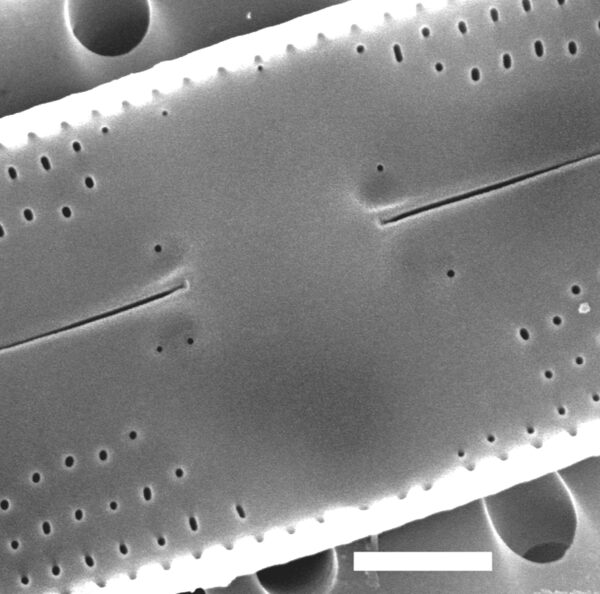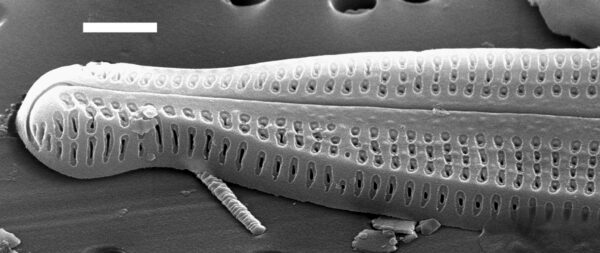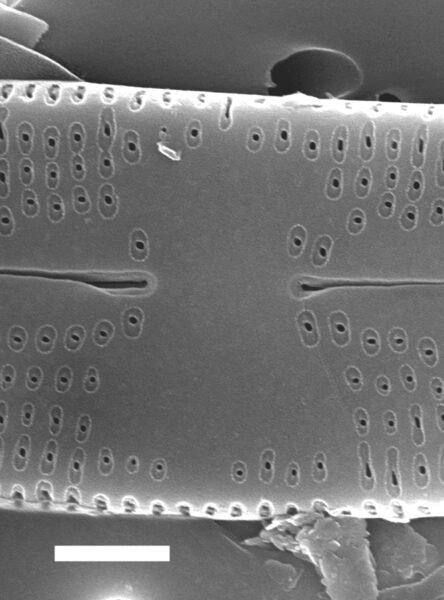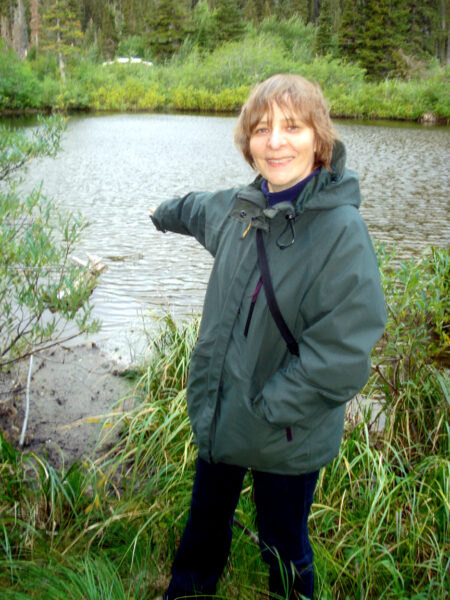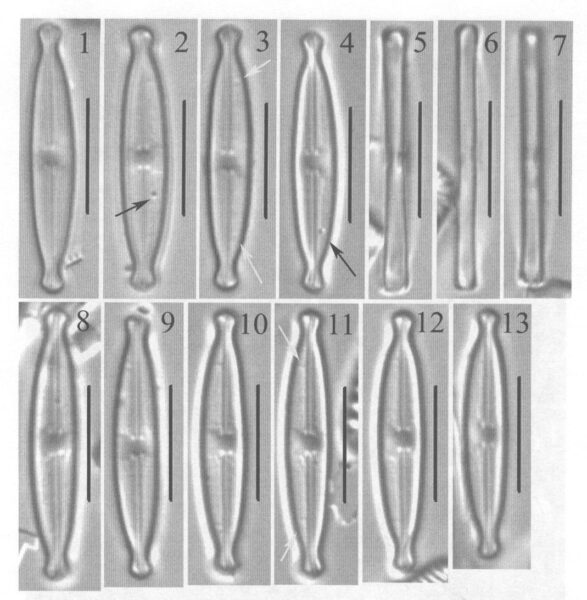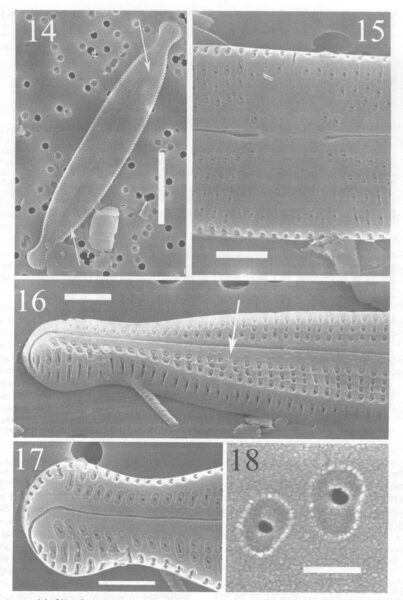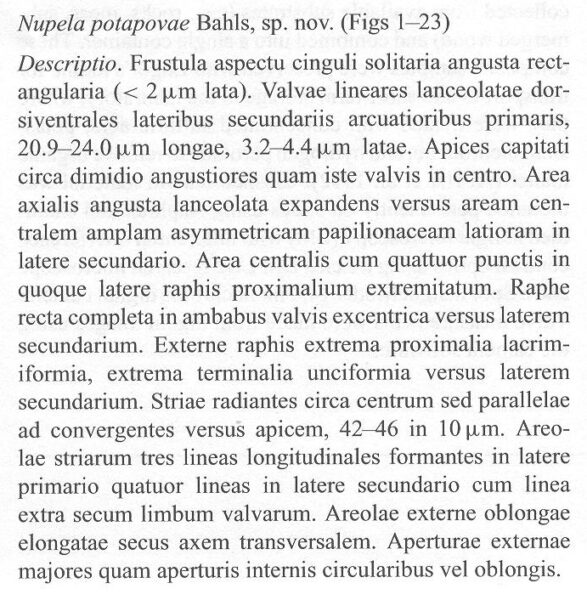Nupela potapovae
-
Category
-
Length Range20.9-24.2 µm
-
Width Range3.2-4.4 µm
-
Striae in 10 µm42-46
-
Reported AsStauroneis species 1 (Bateman and Rushforth 1984)
-
ContributorLoren Bahls - Mar 2012
-
ReviewerSarah Spaulding - Mar 2012
Identification
Description
Frustules are solitary, isovalvar, and narrowly rectangular (< 2 µm wide) in girdle view. Valves are linear-lanceolate and slightly asymmetric to the apical axis, with the secondary side more arched than the primary side. Apices are capitate, about one-half the width of the valve at center. The axial area is narrow and lanceolate, widening gradually to the broad, asymmetrical, butterfly-shaped central area. The central area is wider on the secondary side and distinguished by four distinct depressions, one on each side of the proximal raphe ends. One to two isolated areolae are within each depression. The raphe is straight and complete on both valves, and slightly off-center toward the primary side. External raphe fissures are straight. Proximal raphe ends are small and teardrop-shaped. Distal raphe ends are hooked to the secondary side. Voigt discontinuities are evident on most valves on the secondary side. Striae are difficult to resolve in LM.
Autecology
The type locality of Nupela potapovae is a small pond at 1584 m above mean sea level surrounded by conifer forest in the Northern Rockies. Here it is epiphytic on submerged grass and moss along the shoreline. On the collection date water temperature was 8.6 C, pH was 7.34, and specific conductance was 31 μS/cm.
-
Size Range, µm3
-
Motility
-
Attachment
-
Habitat
-
Colony
-
Waterbody
- Learn more about this
Original Description
LM Morphology. Frustules solitary, isovalvar, narrow rectangular (< 2μm wide) in girdle view (Figs 5–7). Valves linear-lanceolate and dorsiventral, secondary side more arched than primary side, 20.9–24.0 μm long, 3.2–4.4 μm wide (Figs 1-4, 8-13). Apex capitate, about one-half width of valve at centre. Axial area narrow, lanceolate, widening gradually to the broad, asymmetrical, butterfly-shaped central area, which is wider on the secondary side. Central area distinguished by four refractive spots, one on each side of the proximal raphe endings. Raphe straight and complete on both valves, off-centre toward the primary side. External raphe fissures straight, distal endings hooked to the secondary side.Voigt faults on secondary side, evident on most valves (Figs 3, 11, white arrows). Occasionally, small circular depressions occur on the external valve surface (Figs 2, 4, black arrows). Striae are difficult to resolve in LM. SEM morphology. Central area bordered at valve margins by a single interrupted row of areolae (Figs 14–15, 19, 21). One or two isolated areolae in the central area may represent reduced transapical striae (Fig. 15). External proximal raphe endings terminate in small teardrop-shaped pores (Figs 14–15). Distal raphe fissures are hooked to the secondary side, where they extend down onto the apical mantle (Figs 14, 16–17). Internal raphe fissures straight, proximal endings bluntly pointed and bordered on each side by a shallow depression or pit, corresponding to the refractive spots in LM (Figs 21–23). One or two internal areolae openings are associated with, but not centred in, each pit (Fig. 23). Distal raphe fissures terminate in small helictoglossae, which are slightly deflected to the primary side (Fig. 20, black arrow). Striae radiate near the centre, becoming parallel then convergent at the ends, 42–46 in 10μm. Areolae composing the striae are typically arranged in three longitudinal rows on the primary side and four rows on the secondary side of the valve, plus one row along the valve mantle (Figs 14, 16). Longitudinal rows of areolae on the valve face decrease to one row at the narrowest part of the valve and then increase to two rows within the capitate ends (Figs 16–17). The istinction between valve and mantle becomes blurred at the rounded apices (Fig. 16). Areolae are oblong externally and elongate in the transverse axis (Figs 15–17). Externally, areolae appear as shallow oblong depressions, each with a much smaller and more circular internal opening (Figs 18, 22–23); hymenes were not observed.
-
AuthorBahls 2011
-
Length Range20.9-24.0 µm
-
Width3.2-4.4 µm
-
Striae in 10µm42-46
Citations & Links
Citations
-
Publication Link: 10.1080/0269249X.2011.597586
Links
Cite This Page
Bahls, L. (2012). Nupela potapovae. In Diatoms of North America. Retrieved April 16, 2024, from https://diatoms.org/species/nupela_potapovae
Responses
The 15 response plots show an environmental variable (x axis) against the relative abundance (y axis) of Nupela potapovae from all the stream reaches where it was present. Note that the relative abundance scale is the same on each plot. Explanation of each environmental variable and units are as follows:
ELEVATION = stream reach elevation (meters)
STRAHLER = distribution plot of the Strahler Stream Order
SLOPE = stream reach gradient (degrees)
W1_HALL = an index that is a measure of streamside (riparian) human activity that ranges from 0 - 10, with a value of 0 indicating of minimal disturbance to a value of 10 indicating severe disturbance.
PHSTVL = pH measured in a sealed syringe sample (pH units)
log_COND = log concentration of specific conductivity (µS/cm)
log_PTL = log concentration of total phosphorus (µg/L)
log_NO3 = log concentration of nitrate (µeq/L)
log_DOC = log concentration of dissolved organic carbon (mg/L)
log_SIO2 = log concentration of silicon (mg/L)
log_NA = log concentration of sodium (µeq/L)
log_HCO3 = log concentration of the bicarbonate ion (µeq/L)
EMBED = percent of the stream substrate that is embedded by sand and fine sediment
log_TURBIDITY = log of turbidity, a measure of cloudiness of water, in nephelometric turbidity units (NTU).
DISTOT = an index of total human disturbance in the watershed that ranges from 1 - 100, with a value of 0 indicating of minimal disturbance to a value of 100 indicating severe disturbance.
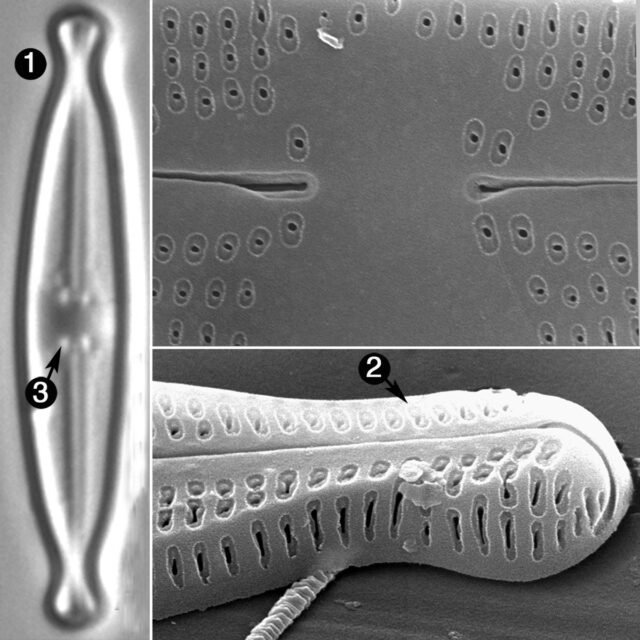
Nupela potapovae
- Valves slightly asymmetric to apical axis
- Apices capitate
- Four depressions in central area
Valves are linear-lanceolate with capitate ends and slightly asymmetric to the apical axis. Four distinct spots (depressions) are present in the in the central area, near the proximal raphe ends.
 Diatoms of North America
Diatoms of North America






